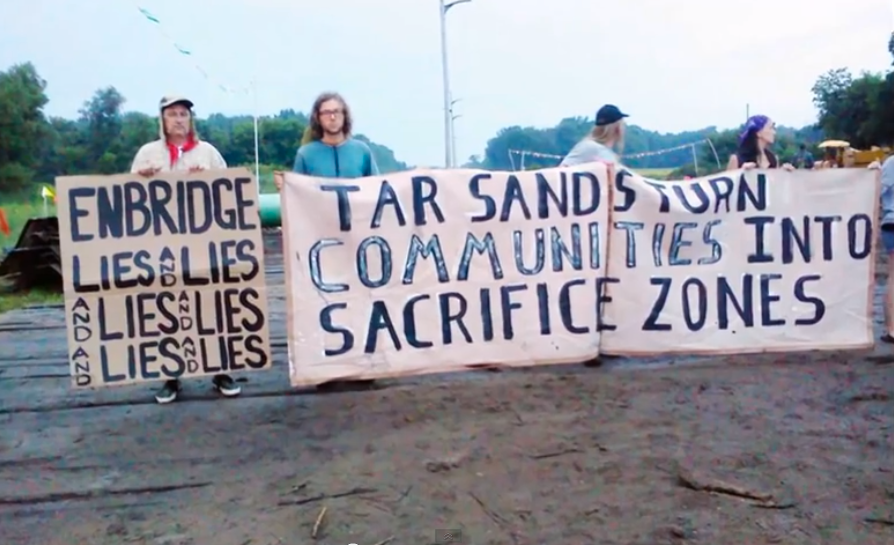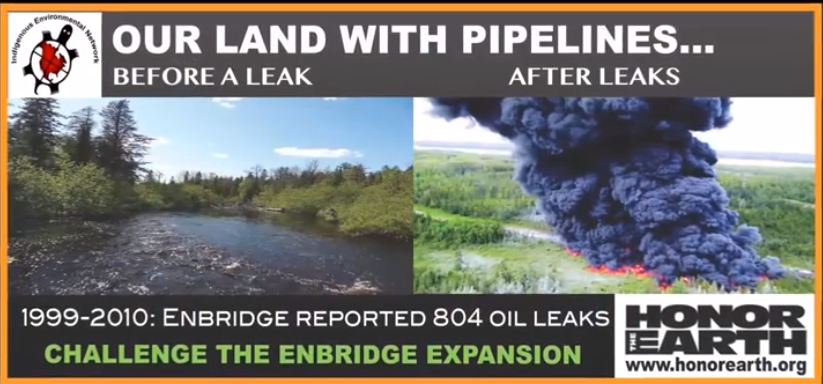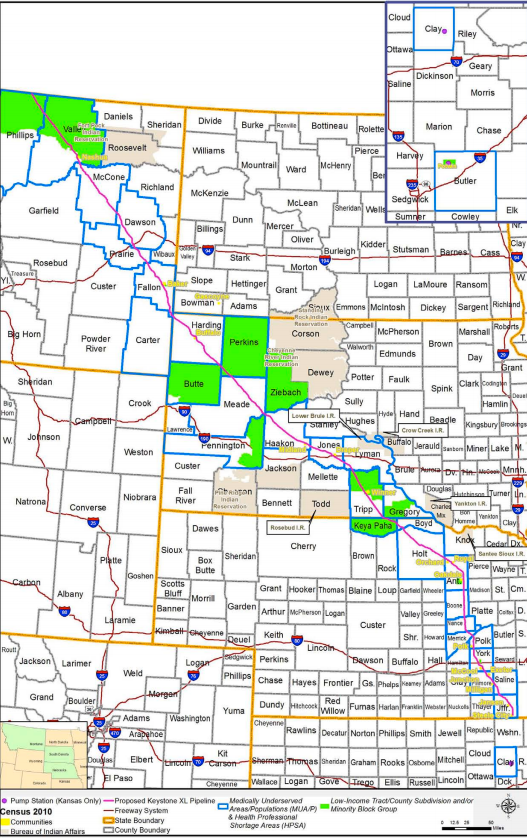 The public debate whether President Obama should approve Keystone XL pipeline is focused on the salient impacts to climate change, natural resources and wildlife. What is missing from this debate is the overriding issue of how does the pipeline directly harm people? Under the law, this is key to any decision. The pipeline should be rejected because it creates (or expands) sacrifice zones for Indians, other minorities and low-income communities. This violates the legal mandate of compliance with environmental justice principles that the State Department must consider when evaluating whether approving the pipeline is in the national interest, a process which is now underway.
The public debate whether President Obama should approve Keystone XL pipeline is focused on the salient impacts to climate change, natural resources and wildlife. What is missing from this debate is the overriding issue of how does the pipeline directly harm people? Under the law, this is key to any decision. The pipeline should be rejected because it creates (or expands) sacrifice zones for Indians, other minorities and low-income communities. This violates the legal mandate of compliance with environmental justice principles that the State Department must consider when evaluating whether approving the pipeline is in the national interest, a process which is now underway.
Many corporations have a history and pattern of locating energy and other projects in or near minority, Indian or low-income communities. They force the burdens of projects designed (they say) to benefit society primarily on these targeted communities, which can thus create "sacrifice zones." The projects devastate the lives of the people in these zones by harming their culture, health, lives, lands, natural resources, wildlife, homes and/or quality of life. These people are marginalized by commodifying them. They are harmed in the name of the "greater good" of the dominant culture for the provision of energy and disposal of waste.
Beneficiaries of these zones are the corporations operating the projects for huge profits and the dominant culture society, who are provided energy to run their air conditioners or cars without suffering the extreme harms forced on the targeted community in the sacrifice zone.
Sacrifice zones have existed for years in environmental and non-environmental contexts, as recently discussed by Chris Hedges and Joe Sacco in Days of Destruction, Days of Revolt. There are many areas in the U.S., they wrote, where people are the victims of oppression, "exploitation, neglect, and degradation" where each area has "served as the sacrificial setting to the insatiable appetites of corporate profit and greed." Hedges and Sacco focused on four sacrifice zones: Pine Ridge Reservation in South Dakota where our national "right" to steal or destroy buffalo herds, land, timber, coal, gold and uranium caused displacement, death, and poverty; the once-flourishing industrial center of Camden, N.J. is now the poorest city in the U.S.; the destructive mountaintop removal mining in southern West Virginia where mining companies blow off the top 500 feet of mountains, poison streams, pollute air, destroy cultural values and leave towns with epidemics of cancer; and Immokalee, Florida, "where migrant agricultural workers (many undocumented) are forced to work in dangerous, deplorable conditions." A common thread in sacrifice zones is promoting corporate profit based on the dehumanizing and forced commodifying of people and community.
While the corporations creating sacrifice zones are primarily responsible, blame also lies with our society that silently stands by, accepting the creation and benefits of the zone. Society remains silent perhaps due to ignorance, or willful blindness as long as destruction is not part of their community. I prefer to think that most people just don't realize that they reap the benefits of energy for homes and businesses because other people's lives and communities are forcibly sacrificed.
The XL pipeline has three sacrifice zones: First Nations in Canada, Indian reservations along the pipeline route and the African American community in Port Arthur, Texas.
Sacrifice Zones Violate Environmental Justice
There is nothing unintentional about the pattern of locating dirty energy projects with significant health and environmental impacts in targeted communities that have a hard time fighting back. But opponents of the XL do not have to establish intentional discrimination. The Executive Order governing environmental justice that is applicable to the XL is based on a standard of "disparate impact." There are many factors considered when determining the national interest, including "compliance with relevant federal regulations and issues."
When assessing the Keystone XL pipeline to determine whether to grant a presidential permit, the "State Department is responsible for coordinating compliance with … environmental requirements applicable to the pipeline." Environmental requirements include compliance with environmental justice mandated by Executive Order 12898. The State Department acknowledges that it has an obligation to review compliance with environmental justice when "processing permit applications."
President Clinton issued Executive Order 12898 – "Federal Actions To Address Environmental Justice in Minority Populations and Low-Income Populations." The title and content of this EO shows that the focus is identifying and addressing disproportionate and adverse human health or environmental effects of a federal agency's programs, policies and activities on minority, Indian or low-income communities. President Clinton made it clear in an accompanying memorandum that the the intent of his EO was providing environmental justice to minority and low-income populations.
The XL Final Supplemental Environmental Impact Statement did an inadequate environmental justice analysis. The Final EIS "concluded that it was not likely that the proposed Project operation would disproportionately adversely impact [minority and low-income populations] during normal operation of the proposed Project," and the "revised environmental justice analysis in this Final Supplemental EIS does not change the conclusions in the Final EIS." The Final SEIS reasons that disproportionate adverse impacts to "environmental justice populations" are not likely "Because the risk of a potential release is roughly equal at all points along the pipeline, the risks associated with such releases would not be disproportionately borne by minority or low-income populations. However, such populations could be more vulnerable should a release occur." The Final SEIS recognizes that "minority or low income populations could be affected" by "an accidental crude oil release," with impacts, such as direct contact with the crude oil, inhaling airborne emissions, and consuming contaminated water or food. This was not deemed a problem because the potential impacts would be mitigated by Keystone's liability ($$$) for the release.
The Final SEIS chapter on the "summary of impacts" shows the importance of impacts to Indian, minority, and low-income communities. A table presents a "brief summary of the proposed Project's impacts on all resources considered," such as geology, water resources, wetlands, wildlife, fisheries, recreational resources, and then socioeconomics:
Other impacts include minor increases in demand for utilities and public services (e.g., police, fire, and emergency medical services), some temporary traffic delays, and [and, oh, btw] minor and temporary impacts on environmental justice populations.
Thus, the claim is that there would be no disproportionate adverse impacts on environmental justice communities from the construction or operation of the XL pipeline despite the creation or expansion of sacrifice zones.
FIRST NATIONS

The XL pipeline originates in Canada. For decades, First Nation leaders in Canada have been fighting to protect their ancestral homelands from the
"slow industrial genocide" of tar sands extraction that threatens
"the fundamental right to exist as Indigenous peoples." The
Indigenous Environmental Network discussed this sacrifice zone and the failure of the State Department to implement U.S. environmental justice policy:
There is substantial documentation of the devastation of the environment, ecosystem, water, air, and more recently the health of the Native people living in the national sacrifice zone of the tar sands. Evidence of rare cancers linked to petroleum contamination is on the increase. The Alberta tar sands are far away, in another country, but the Obama administration could be making a decision that can directly affect the health and future of the Dene, Cree and Metis’ First Nations people. The U.S. Department of State addresses human rights issues worldwide, however, in this report; it completely ignores its responsibility to apply U.S. policy on environmental justice and its commitment to address human rights.
Alberta's tar sands operations have had a negative impact on First Nation communities for years. With people, culture, and natural resources objectified into commodities, the path is paved to contaminate water, land, and food supplies while stealing land and livelihoods and robbing people of their health and lives. For years, First Nations people have asked others to listen to their recounting of what is happening to them. In 2007, Celina Harpe (Cree community of Fort MacKay) described the increased cancer deaths, polluted water and air, contaminated food supply of fish and wildlife, and how they have been ignored when raising these issues of how their lives will never be the same and how they are "not treated like humans":
For years, studies indicated higher cancer rates in First Nation communities downstream from the tar sands. Another study found deformed fish with golfball-sized tumors bulging outward, while others were bent or crooked due to missing parts of their spines, or were missing a snout, were different colors, or were covered with lesions.
 Aji wrote about the impact of the XL on U.S. tribal lands. (The Map from SEIS where the beige color is Indian Reservations) "The proposed pipeline cuts a path across six states, each with tribal lands. In some cases, the pipeline will run near enough to such lands to endanger them in event of a spill; in others, the pipeline will go directly through tribal lands, and a spill will do much more than merely endanger them. …But the pipeline need not cross, or even abut, tribal lands to inflict terrible damage. A spill in the Ogallala Aquifer has the potential to contaminate the watersheds of eight states: South Dakota, Wyoming, Nebraska, Colorado, Kansas, Oklahoma, Texas, and New Mexico. …That's nearly 2,000 separate water crossings, many of which serve the tribes not only in the six states the pipeline will cross, but in adjacent and downstream states, as well."
Aji wrote about the impact of the XL on U.S. tribal lands. (The Map from SEIS where the beige color is Indian Reservations) "The proposed pipeline cuts a path across six states, each with tribal lands. In some cases, the pipeline will run near enough to such lands to endanger them in event of a spill; in others, the pipeline will go directly through tribal lands, and a spill will do much more than merely endanger them. …But the pipeline need not cross, or even abut, tribal lands to inflict terrible damage. A spill in the Ogallala Aquifer has the potential to contaminate the watersheds of eight states: South Dakota, Wyoming, Nebraska, Colorado, Kansas, Oklahoma, Texas, and New Mexico. …That's nearly 2,000 separate water crossings, many of which serve the tribes not only in the six states the pipeline will cross, but in adjacent and downstream states, as well."
The Anishinaabe activist Winona LaDuke talks about national sacrifice areas:
PORT ARTHUR, TEXAS
At the end of the XL pipeline are the refineries in Port Arthur. How would you feel if you saw a dozen or more WARNING signs of high pressure petroleum pipelines, complete with phone numbers to call in case of emergency, located across the street from your home? (picture here)
Port Arthur is a town in Jefferson County, Texas, where the 3,600-acre Motiva plant (Shell Oil and Saudi Aramco) and the 4,000-acre plant Valero project together refine more than 900,000 barrels of crude oil a day. "In 1952, Port Arthur’s white town fathers took public housing dollars from Washington and erected these apartments directly on the refineries’ fence," which is why they are called "fence-line community." West Port Arthur is 95% African American. EPA data shows Jefferson County "among the very worst in the nation for air releases of chemicals known to cause cancer, birth defects, and reproductive disorders." Texas Cancer Registry data indicates that "cancer rates among African Americans in Jefferson County are roughly 15 percent higher than they are for the average Texan. Shockingly, the mortality rate from cancer is more than 40 percent higher." A university study found that "residents of Port Arthur were four times more likely than people just 100 miles upwind to report suffering from heart and respiratory conditions; nervous system and skin disorders; headaches and muscle aches; and ear, nose, and throat ailments."
There are also "flaring events" of toxic gas. This flaring event happened last April and was videotaped, showing 8 towers spewing orange/yellow fire and black smoke next to homes:
Port Arthur needs the current toxic pollution ended, not increased.
The absence of public acknowledgement and opposition to sacrifice zones sends an implicit message of "consent" to their continued use. "Refinery spokespeople acknowledge that their facilities are emitting toxic chemicals," but also know that most Americans are willing to allow it to continue. The corporate operators of sacrifice zones apparently consider killing and sickening people as simply a business expense for which they pay fines, which are a tiny part of their business profits, when caught committing violations. And the GOP work to continue sacrifice zones by supporting measures that would prevent the Environmental Protection Agency from regulating greenhouse gases emitted from power plants, factories and refineries, including sites in Port Arthur, Texas.
The Keystone XL pipeline will create, exacerbate and expand the sacrifice of people with already higher rates of illness, like cancer, asthma and cardiovascular disease. If our society continues to remain silent, then governments and corporations will continue to authorize projects or policies with inherent racism to create new and expand the existing sacrifice zones that commodify people, culture and natural resources.
Our DK Blogathon Team will be hosting a blogathon later this month as part of a campaign to encourage people to submit comments opposing the XL pipeline during this period of the National Interest Determination. It's our opportunity to make our voices heard directly to the White House without the interference of media, lobbyists or the GOP. I am in the process of writing a diary that I will post this week that provides some guidance on the issues that might be addressed to provide the most effective comments.
The comment period is open now until March 7th. Comments may be posted at this page established for NID comments. It's easy. Click onto the blue "comment now" box, and you will find an empty comment message box similar to when you post comments at DK. You can also post a comment by attaching a pdf file to the comment box.
Please remember that comments are not private. "The comments will not be edited to remove identifying or contact information, and the State Department cautions against including any information that one does not want publicly disclosed."


